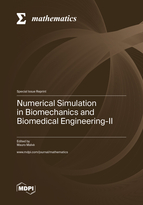Numerical Simulation in Biomechanics and Biomedical Engineering-II
A special issue of Mathematics (ISSN 2227-7390). This special issue belongs to the section "Engineering Mathematics".
Deadline for manuscript submissions: closed (31 January 2023) | Viewed by 20467
Special Issue Editor
Interests: fluid–structure interaction; biofluid mechanics; computational modelling in biomechanics; cardiovascular biomechanics in healthy and diseased conditions; animal biomechanics; respiratory mechanics; medical devices
Special Issues, Collections and Topics in MDPI journals
Special Issue Information
Dear Colleagues,
This Special Issue is a continuation of the previous successful Special Issue “Numerical Simulation in Biomechanics and Biomedical Engineering” in the MDPI journal Mathematics.
In the last decades, the improvement of the computational technology has allowed for the introduction of advanced numerical models and high-performance simulations in several fields of the engineering. In particular, biomedical engineering, which can be considered as a bridge discipline between engineering and medicine, and combines the knowledge of several aspects of both fields, has received great attention from the scientific community for its direct relation to human health. In a more general meaning, biomedical engineering also includes the study of the processes related to nature and animals.
Specific applications can be found in the understanding of human pathologies and diseases; in the advancement of the medical health care; and in the improvement of the diagnosis, of the therapies, and of the clinical outcomes, among other aspects. However, biomedical engineering should theoretically also help to reduce the number of tests in animals, and should also contribute to the improvement of their health care. More recent applications can be found in the analysis of biological problems, such as the cells’ culture and motility, and the microfluidic and diffusion processes.
This Special Issue is focused on the numerical modelling of the complex problems in the field of biomechanical and biomedical engineering, which include, but are not limited to, cardiovascular mechanics, computational biofluid dynamics, the application of novel numerical algorithms to the biomedical engineering, advances on constitutive modelling in biomechanics, diffusion models in tissue engineering, and the use of the stenting technique in humans and animals. As such, high-quality original research papers are welcome.
Prof. Dr. Mauro Malvè
Guest Editor
Manuscript Submission Information
Manuscripts should be submitted online at www.mdpi.com by registering and logging in to this website. Once you are registered, click here to go to the submission form. Manuscripts can be submitted until the deadline. All submissions that pass pre-check are peer-reviewed. Accepted papers will be published continuously in the journal (as soon as accepted) and will be listed together on the special issue website. Research articles, review articles as well as short communications are invited. For planned papers, a title and short abstract (about 100 words) can be sent to the Editorial Office for announcement on this website.
Submitted manuscripts should not have been published previously, nor be under consideration for publication elsewhere (except conference proceedings papers). All manuscripts are thoroughly refereed through a single-blind peer-review process. A guide for authors and other relevant information for submission of manuscripts is available on the Instructions for Authors page. Mathematics is an international peer-reviewed open access semimonthly journal published by MDPI.
Please visit the Instructions for Authors page before submitting a manuscript. The Article Processing Charge (APC) for publication in this open access journal is 2600 CHF (Swiss Francs). Submitted papers should be well formatted and use good English. Authors may use MDPI's English editing service prior to publication or during author revisions.
Keywords
- computational biomechanics
- numerical modeling of medical devices
- computational biofluid mechanics
- patient-specific-based numerical models
- finite element method
- diffusion models in the tissue engineering
- constitutive models
- numerical methods in the biomedical engineering
- numerical algorithms and imaging technique






